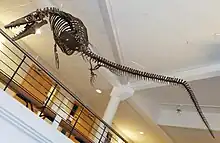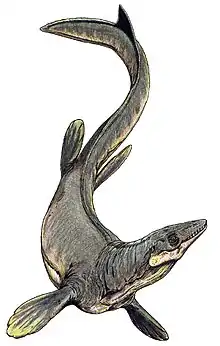| Plesioplatecarpus Temporal range: Late Cretaceous, | |
|---|---|
 | |
| Reconstructed skeleton in Geocentrum, University of Uppsala | |
| Scientific classification | |
| Domain: | Eukaryota |
| Kingdom: | Animalia |
| Phylum: | Chordata |
| Class: | Reptilia |
| Order: | Squamata |
| Superfamily: | †Mosasauroidea |
| Family: | †Mosasauridae |
| Clade: | †Russellosaurina |
| Subfamily: | †Plioplatecarpinae |
| Tribe: | †Plioplatecarpini |
| Genus: | †Plesioplatecarpus Konishi & Caldwell, 2011 |
| Species: | †P. planifrons |
| Binomial name | |
| †Plesioplatecarpus planifrons | |
| Synonyms | |
|
Platecarpus planifrons (Cope, 1874) | |
Plesioplatecarpus is an extinct genus of plioplatecarpine mosasaur known from the Late Cretaceous (middle Coniacian to middle Santonian stage) of the northern Gulf of Mexico and the Western Interior Basin of North America.[1]
History

Plesioplatecarpus was originally named by Cope in 1874 as Clidastes planifrons, and later it was reassigned to Platecarpus. The name Plesioplatecarpus was erected by Takuya Konishi and Michael W. Caldwell in 2011 to incorporate Platecarpus planifrons, which was found to be distinct from Platecarpus in a phylogenetic analysis. It is known from the holotype AMNH 1491, a nearly complete skeleton. Many other specimens are also referred to this species, including FHSM VP2116 and 2296, UALVP 24240 and 40402 and YPM 40508.[1]
References
- 1 2 Konishi, Takuya; Michael W. Caldwell (2011). "Two new plioplatecarpine (Squamata, Mosasauridae) genera from the Upper Cretaceous of North America, and a global phylogenetic analysis of plioplatecarpines". Journal of Vertebrate Paleontology. 31 (4): 754–783. doi:10.1080/02724634.2011.579023. S2CID 85972311.
